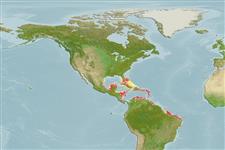Common names from other countries
Environment: milieu / climate zone / depth range / distribution range
Ecologia
; estuarina; intervalo de profundidade 2 - 15 m (Ref. 415). Tropical
Western Central Atlantic.
Length at first maturity / Tamanho / Peso / Idade
Maturity: Lm ? range ? - ? cm Max length : 0.2 cm OT macho/indeterminado; (Ref. 415)
Encrusting sponge, 0.1 - 0.2 cm thickness. Smooth, and slippery surface, with regularly dispersed oscula: 0.2 - 0.3 cm in diameter. A conspicuous star-shaped canal system surrounds each oscula (Ref. 415). Color: light to dark blue or violet. Leathery (Ref. 85482).
Maximum body thickness: 0.2 cm (Ref. 415). On dead coral in reef environments: 2 to 15 m deep (Ref. 415). Also found in mangroves (Ref. 86836). Favors coral undersides, overhangs, and crevices in shallow and deep reefs and hard bottoms (Ref. 85482).
Life cycle and mating behavior
Maturidade | Reprodução | Desova | Ovos | Fecundidade | Larvas
Members of the class Demospongiae are hermaphroditic. Life cycle: The zygote develops into parenchymella larva (free-swimming) before settling down on a substrate where it grows into a young sponge.
Collin, R., M.C. Díaz, J. Norenburg, R.M. Rocha, J.A. Sánchez, M. Schulze, A. Schwartz and A. Valdés. 2005. (Ref. 415)
Categoria na Lista Vermelha da IUCN (Ref. 130435)
Categoria CITES (Ref. 108899)
Not Evaluated
Not Evaluated
Ameaça para o homem
Harmless
Utilização humana
| FishSource |
Ferramentas
Fontes da internet
Estimates based on models
Preferred temperature
(Ref.
115969): 26.4 - 28.2, mean 27.5 (based on 517 cells).
Vulnerabilidade
Low vulnerability (10 of 100).
Categoria de preço
Unknown.
